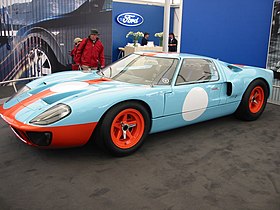Our website is made possible by displaying online advertisements to our visitors.
Please consider supporting us by disabling your ad blocker.
Ford GT40
| Ford GT40 | |
|---|---|
 | |
| Overview | |
| Manufacturer | |
| Production | 1964–1969[1] 105 produced[2] |
| Assembly |
|
| Designer | Ron Bradshaw |
| Body and chassis | |
| Class | Group 4 sports car Group 5 sports car Group 6 sports prototype |
| Body style | |
| Layout | MR layout |
| Powertrain | |
| Engine | |
| Transmission | Mk1 & Mk3: 5-speed manual Mk2 & Mk4: 4-speed manual |
| Dimensions | |
| Wheelbase | 95 in (2,413 mm)[3] |
| Length | 160 in (4,064 mm) |
| Width | 70 in (1,778 mm) |
| Height | 40.5 in (1,029 mm) |
| Kerb weight | 1,800–2,300 lb (816–1,043 kg) (1966, Mk IIA)[4] |
| Chronology | |
| Successor | Ford P68 (racing heritage) Ford GT (street heritage) |
The Ford GT40 is a high-performance endurance racing car designed and built by the Ford Motor Company. It grew out of the "Ford GT" (for Grand Touring) project, an effort to compete in European long-distance sports car races, against Ferrari, who had won the prestigious 24 Hours of Le Mans race from 1960 to 1965. Ford succeeded with the GT40, winning the 1966 through 1969 races.
The effort began in the early 1960s when Ford Advanced Vehicles began to build the GT40 Mk I car, based upon the Lola Mk6, at their base in Slough, UK. After disappointing race results, the engineering team was moved in 1964 to Dearborn, Michigan, USA to design and build cars by Kar Kraft. All chassis versions were powered by a series of American-built Ford V8 engines modified for racing.
In 1966, Ford with the GT40 Mk II car broke Ferrari's winning streak at Le Mans, thus becoming the first American manufacturer to have won a major European race since Jimmy Murphy's triumph with Duesenberg at the 1921 French Grand Prix.[5][6][7] In 1967, the Mk IV car became the only car developed and assembled entirely (both chassis and engine) in the United States to achieve the overall win at Le Mans.[8]
The Mk I, the oldest of the cars, won in 1968 and 1969, the second chassis to win Le Mans more than once. (This Ford/Shelby chassis, #P-1075, was believed to have been the first until the Ferrari 275P chassis 0816 was revealed to have won the 1964 race after winning the 1963 race in 250P configuration and with a 0814 chassis plate[9]). Its American Ford V8 engine, originally of 4.7-liter displacement capacity (289 cubic inches), was enlarged to 4.9 litres (302 cubic inches), with custom alloy Gurney–Weslake cylinder heads.
The "40" represented its height of 40 inches (1.02 m), measured at the windscreen, the minimum allowed. The first 12 "prototype" vehicles carried serial numbers GT-101 to GT-112. Once "production" began, the Mk I, Mk II, Mk III, and Mk IV were numbered GT40P/1000 through GT40P/1145, and thus officially "GT40s". The Mk IVs were numbered J1-J12.
The contemporary Ford GT is a modern homage to the GT40.
- ^ Ford Chassis Numbers Retrieved on 27 January 2010
- ^ "Debut for 'last' GT40" Retrieved on 2 February 2017
- ^ Cardew, Basil (1966). Daily Express Review of the 1966 Motor Show. London: Beaverbrook Newspapers Ltd.
- ^ "GT40 Specifications". Archived from the original on 6 September 2012. Retrieved 29 November 2016.
- ^ "Ford GT40 Mark II". Supercars.net. 1 March 2004. Retrieved 24 September 2010.
- ^ "1965 - 1966 Ford GT40 Mk II - Images, Specifications and Information". Ultimatecarpage.com. 21 December 2006. Retrieved 9 August 2011.
- ^ "The ACO statistics of winners" (PDF). Archived (PDF) from the original on 27 June 2018.
- ^ "The Collection". simeonemuseum.org. 23 August 2015.
- ^ "RM Sotheby's - Private Sales - 1963 Ferrari 275 P". Retrieved 14 April 2020.
Previous Page Next Page


